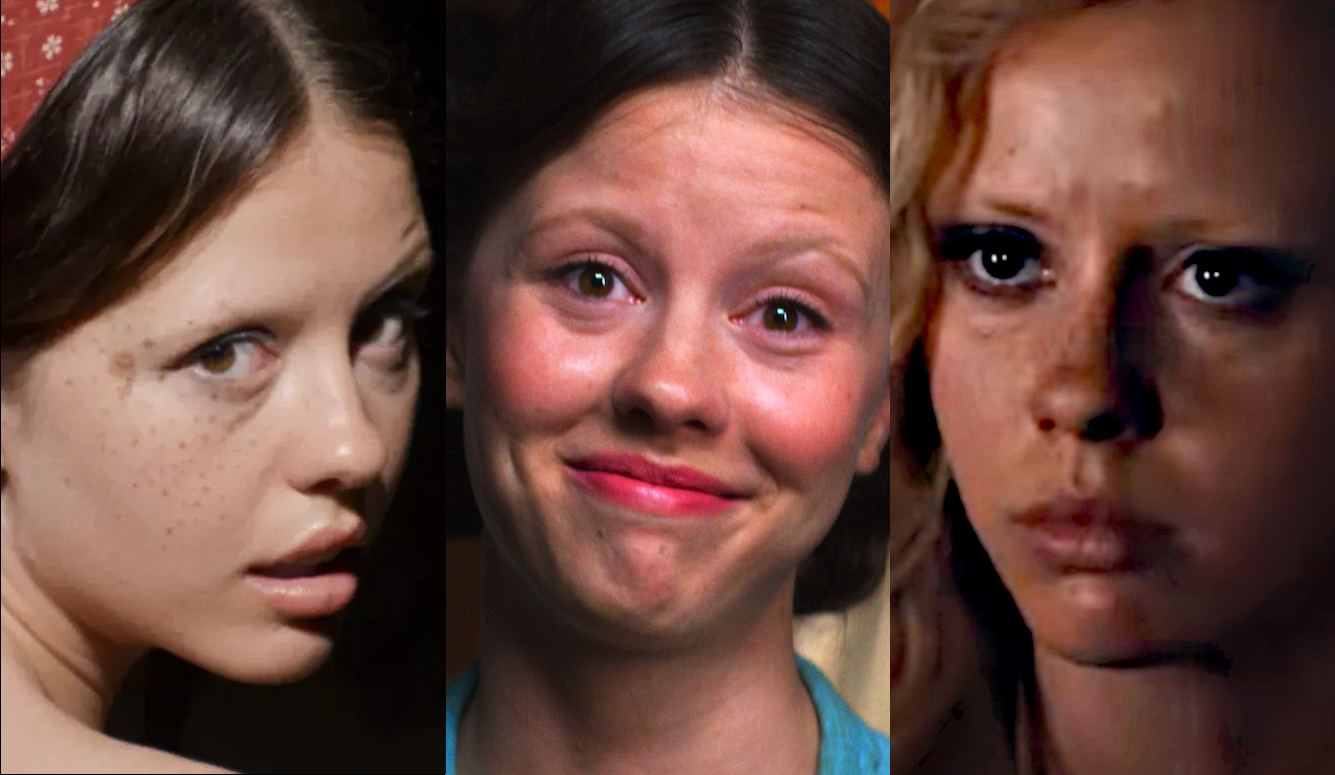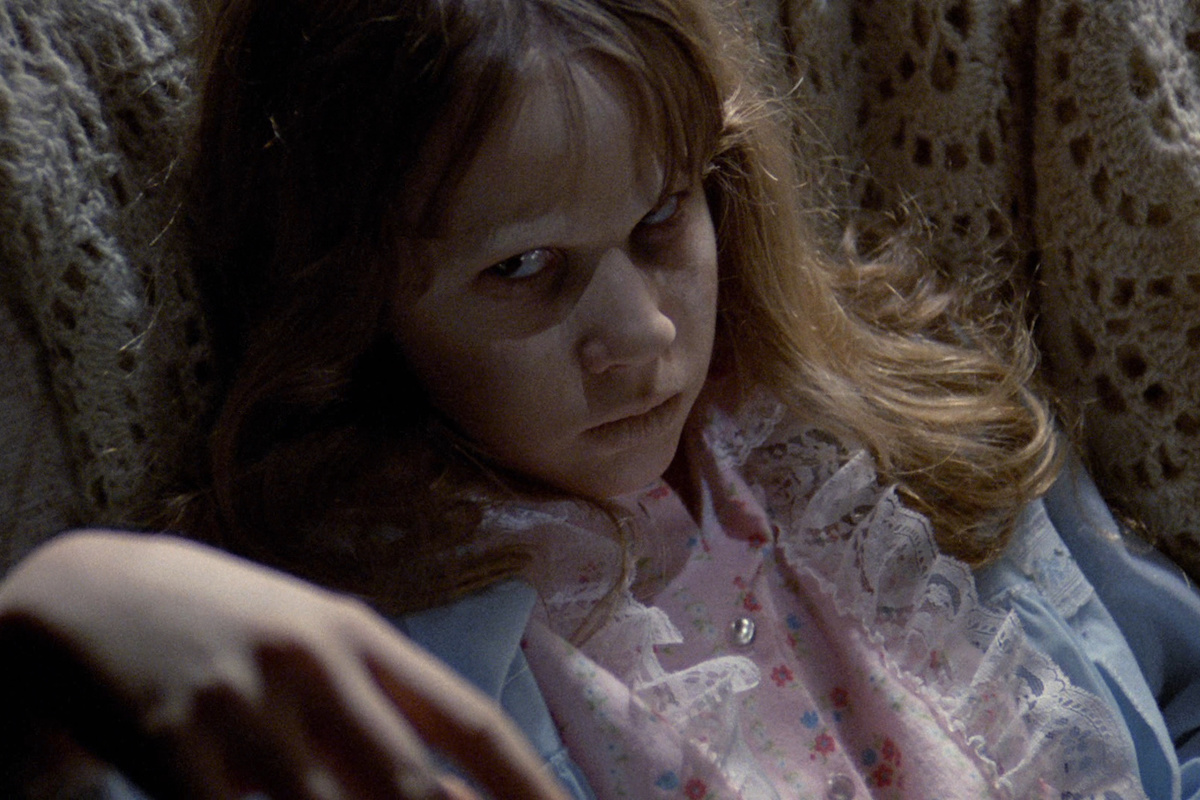Art and Culture
Texas Porn Star Massacres
Ti West’s clever and original ‘X’ trilogy is elevated postmodern horror at its finest and its director’s best work to date.

There aren’t many writer-directors with the confidence to end a genre film with an eight-minute monologue delivered in a single unbroken close-up. Nor to have the same actor hold an excruciating smile throughout its end-credits. But these are the kind of risks Ti West takes in his X trilogy, a boutique horror franchise that began with X, continued with its prequel Pearl, and concludes with its recent sequel Maxxxine. Returning to film after five years in television, West is one of the most accomplished (and entertaining) auteurs to emerge from A24 and Blumhouse, independent studios that are currently leaning into a subgenre of arthouse cinema that has come to be known as “elevated horror.”
Elevated horror is distinguished from mass-market horror’s reliance on recycled templates and jump scares by a willingness to explore contemporary issues and themes. This isn’t an especially new idea—films like Possession (1981), Don’t Look Now and The Exorcist (1973), Rosemary’s Baby (1967), and The Innocents (1961) all attempted to provide stimulation for the mind as well as the gut, and novelists were producing thoughtful and intelligent horror fiction long before cinema was even invented. But the recent glut of cerebral scary movies has tended to be more earnest and downbeat. Get Out (2017) is about liberal racism, The Babadook (2014) is about repressed trauma, Hereditary (2018) is about generational trauma, and It Follows is a metaphor for AIDS.

Some of these films have used the medium in innovative and unusual ways as well. Roger Eggers framed his nightmarish period piece The Lighthouse (2019) in the obscure Movietone aspect ratio of 1.19:1 (employed very briefly by the US film industry in the early 20th century) and he abandoned digital for Kodak Double-X, a slow stock that requires blinding halogen bulbs for proper exposure. Ari Aster’s Midsommar (2019) used Panasonic’s new Light Iron Color 2 to intensify the hallucinogenic feel of its summer light and bright costumes. And while elevated horror has its fair share of bloody and inventive kills, its interest in character and tone has managed to attract respected stars like Willem Dafoe, Toni Collette, Gabriel Byrne, and Jessie Buckley.
Still, as a term, “elevated horror” is fairly woolly. Like all categories, its borders are fuzzy and it mostly exists to serve the human need to make connections and draw distinctions. And—a cynic might observe—it has given critics and academics something to talk about. Which is why some horror fans allege that “elevated horror” is simply a branding exercise to help market the work of a few independent production houses and confer artistic respectability on a genre often disdained by critics. There may be some truth to that, but the identification of new genres and subgenres in all art forms usually marks a shift from existing creative norms and staples. Given that each art form evolves in response and in relation to its existing context, genre boundaries are necessarily permeable. This is certainly true of horror.
Audiences can tell the difference. Aggregator sites like Rottentomatoes.com indicate that conventional horror cinema tends to be much better received by the public than by critics, while arthouse horror appeals more to critics than to the general public. This is not especially surprising. On one hand, the visceral nature of horror cinema short-circuits the snobbery that gatekeeping critics use to justify their existence. The Lighthouse may inspire reams of film-theory papers discussing its themes and technical innovations, but if it is not frightening then, as a horror film, it is surely failing in its primary task (I was initially dazzled by its technique but I was soon bored to irritation by its galloping pretension). On the other hand, it can take a while for popular taste to embrace a fresh take on familiar material, so maybe the public and critical ratings on review aggregators will start to converge with the passage of time.
The most satisfying arthouse horror combines originality with enough familiarity to ensure popular appeal. Like Jordan Peele (who wrote and directed Get Out and Nope), Ti West is an auteur alert to the needs of his audience. His horror films have plenty for chin-strokers to discuss and debate along with a good deal of the gleeful bloody carnage that genre fans want and expect from a horror film.
The X trilogy is West’s best work to date and a terrific representative of this exciting subgenre. Its unique structure was the result of inspiration, hard work, and happenstance, but that is part of its appeal. Each instalment stands on its own, linked by a general theme and by an actor playfully cast in two roles, but each film has its own tone, look, period, and presentation.
The first of the three films to be released (but the second in the narrative’s chronology) was X (2022), which is set in 1979 at the height of America’s Golden Age of Pornography. In an interview with IndieWire, West’s longtime cinematographer Eliot Rocket explained how he tried to capture the look and feel of 1970s’ grindhouse flicks by using practical sources of period lighting:
“This started back with ‘House of the Devil,’” said Rocket, referencing the 2009 horror film he shot for West. “We were trying to make a movie that felt not just like a period, but the whole thing felt more like an artifact from that time.”
[...]
“On ‘X,’ I endeavored to pretty much do those movies with lighting fixtures that would have been available in that era,” said Rocket. “I cheated a little bit, I used a few LED tubes here and there on closeups, but predominantly, it was all these old fixtures that we got from the rental house. It was back of the shelves, super dusty things.”
X tells the story of Maxine, a stripper who has fled her domineering televangelist father and is now determined to become famous by starring in a hardcore flick produced by her middle-aged boyfriend. Cast and crew assemble at a barn rented from Howard and Pearl, the weird geriatric couple who live in the adjacent farmhouse. When Pearl’s libido is inflamed after she spies on one of the film’s sex scenes, she attempts to seduce the director. Following the inevitable rejection, she embarks on a gloriously bloody killing spree with her husband of which Maxine is the sole survivor. “I’m a fucking star!” Maxine rages. “The whole world is gonna know my name. I will not accept a life I do not deserve!” After crushing Pearl’s head under the wheel of the couple’s truck, she sets off for Hollywood.
Typically, horror movies provide a kind of moral justification for their carnage with the puritanical message that “the wages of sin is death.” Teenagers experimenting with drugs and/or sex receive their grisly deserts, while virgins tend to escape slaughter. But here, our final girl celebrates the sexual liberation that defines her goals and her defiant rejection of the oppressive morality with which she was raised. The need to escape an ordinary life—to become somebody—and the conflation of celebrity with love are the trilogy’s overriding themes. Sex is merely a means to the end, and pornography is the platform for the sales pitch. The enemy of success is age, the worm in the apple that inevitably destroys youth and beauty.
Two of X’s most disturbing scenes deal with geriatric sex, a taboo seldom violated by cinema of any kind. In one of these, Pearl crawls into Maxine’s bed and presses her cadaverous husk against the young woman’s body as she sleeps, stroking her skin in anguished mourning for her own lost youth and beauty. In the other, Maxine hides beneath the couple’s bed as Howard attempts to satisfy Pearl’s needs, his desiccated and bony frame labouring over his wife’s frail body. These extraordinary images are at once repulsive and tragic, shocking and sad—a harrowing glimpse of our future desires thwarted by decay.
Howard and Pearl may be serial killers, but they’re unorthodox horror villains. Psychologically, their behaviour is an extension of familiar human instincts driven into derangement and depravity. Maxine’s fear of ageing into Pearl and the murderous fury that her youthful beauty elicits hint at an unspoken and often unrecognised truth about generational conflict—we resent those who have what we’ve lost and reject those who represent what we fear. West underlines this theme by casting new scream queen Mia Goth in both roles.
Born Mia Gypsy Mello da Silva Goth, her surname is deliciously appropriate. “All my characters are me, turned up or turned down,” she has remarked. “It’s all me exploring different facets of myself.” This is a somewhat banal comment, since what she is describing is true of all artists to a degree, but it is perhaps especially true of Goth given the upheavals of her peripatetic childhood.
When Goth was just a few weeks old, her twenty-year-old mother left a failed relationship with Goth’s father in Britain and took her daughter to rejoin her family in Brazil. They returned to Britain when Goth was five and then moved to Canada when she was ten. “We tried to live with my dad and that was a disaster, not good at all,” Goth recalls. Bullied through nine schools in a single year, Goth became an accomplished liar: “I would say my dad is a brain surgeon or my mum is a chef.” Back in Britain, she took up modelling at fourteen, and was hired to appear in the second part of Lars von Trier’s Nymphomaniac epic where she met her former husband Shia LaBoeuf. The couple were married in a live-streamed Las Vegas wedding by an Elvis impersonator.
A career in horror films was “never the plan,” Goth insists, but her famous scream came naturally. So did her writing ability, apparently. She co-wrote the trilogy’s second entry, Pearl (2022), a prequel that provides the backstory to X’s monstrous psycho-biddy. X was shot in New Zealand during the COVID pandemic when Hollywood productions were suspended. During the required two-week quarantine before the shoot, it occurred to West that it would be a shame to waste the opportunity to make a second film at the same time, especially since the costs would be amortised by reusing the main set and production team. He and Goth spitballed ideas about Pearl’s youth and then co-wrote a script that closes with a monologue for the ages.
“I would write in a kind of stream of consciousness,” Goth told Moviemaker, “and then I would send that out to [Ti]. I would often write in the mornings, I would get up very early, I would get my coffee, set my computer overlooking my apartment, and I just started writing. And I’d send it off to him, and he would incorporate that into the script format because I’ve never written a script, I’ve never studied screenwriting.”
This process undoubtedly helped Goth inhabit Pearl and her spiritual twin Maxine. It may also explain why Pearl is the most character-centred and the least plot-driven film in the trilogy. As a young woman, Pearl feels trapped on her family’s Texas farm: “I don’t want to end up like Mama,” she laments. “I want to be dancing up on the screen like the pretty gals in the pictures. I want what they have so badly, to be perfect, to be loved from as many people as possible to make up for all my time spent suffering. Sometimes I wake in the middle of the night and the fear washes over me, ’cause what if this is it? What if this is right where I belong?”
But it is 1918, and Pearl’s dreams must contend with the film’s second major theme: family dysfunction, repression, and resentment. Her husband is fighting in World War I, a conflict that has made her German immigrant family outcasts, and the Spanish flu has (like COVID) restricted social life. Pearl lives under the thumb of her mother, who calls her daughter her “biggest failure,” and she is forced to feed, bathe, and toilet her paralysed father.
When she sneaks off to the movies, the predatory projectionist plays on her dreams and attempts a seduction by showing her A Free Ride (1915, the first archived porno). When she auditions for a travelling dance troupe, the role she covets is won by her rich, popular cousin. Something has to give and when it does, the results are spectacular—immolation, suffocation, a pitchfork, and an axe leave Pearl with sundry body parts to feed to Theda, the family alligator (named after silent film star Theda Bara). When her husband Howard returns from the war, he finds a dining-room table arranged with the decomposing remains of her parents.
Setting Pearl in the distant past avoids the trap that some prequels fall into. Who wants to see the set-up to a story, the ending of which they already know? (This was the conceptual flaw in George Miller’s otherwise brilliant Furiosa which ended at the beginning of his Mad Max triumph Fury Road.) And the period provides West with a vehicle to showcase his technical versatility. He originally pitched the film to A24 as a black-and-white pastiche of German expressionist horror, but the production house already had several black-and-white films on its roster. So, West adopted the eye-popping technicolor aesthetic of Hollywood’s Golden Age instead.

Peter Jackson’s Park Road Post Production created a faux Technicolor effect by using a three-strip imitation overlay with aggressive colour correction for full saturation. Combined with the film’s brightly painted sets, vivid costumes, and musical numbers, the evocative cinematography turns the film into a childlike fantasy of murder—a children’s movie like The Wizard of Oz reimagined as a nightmare acid trip.
Pearl was shot barely three weeks after X wrapped, and it premiered at the Venice International Film Festival less than six months after X’s release. Both films were critical and indie box-office hits. (X earned $15 million on a budget of $1 million; Pearl earned $9.5 million on a similar budget.) Their success ensured a green light for Maxxxine, the trilogy’s final instalment, shot with a budget greater than those of the first two films combined and with an elite cast including Kevin Bacon, Bobby Cannavale, Elizabeth Debicki, and Giancarlo Esposito.
Maxxxine shares every connection in the franchise. Its central theme is the drive to escape one’s past for a life of public adulation (its secondary theme is karma), and once again, Mia Goth’s double-role is the central casting delight. The story is set during the 1980s, when slasher flicks dominated the horror genre and a serial killer stalked LA and San Francisco, and it’s decorated with the garish sights and sounds of that era—bright neon lights and a synth-heavy soundtrack.
Six years after the events portrayed in X concluded, we find Maxine working in Hollywood as a successful porn star (with the personalised licence plate “MAXXXINE”) and getting ready to make the leap into mainstream film (or at least into the sequel of a slasher flick). But no one can escape their past, especially when it’s been recorded on cameras left at a crime scene. Compounding Maxine’s problems, the Night Stalker—real-life serial killer Richard Ramirez, who was still at large when the film’s events take place—is thought to be killing the cast of her movie. Before the opening credits, we’re treated to Bette Davis’s famous quote: “In this business, until you’re known as a monster, you are not a star.” Well, Maxine is a star.
Echoing the meta structure of X, Maxxxine is a horror movie about the making of a horror movie. A lot of commercial horror bypasses the brain, but this postmodern gimmick—like the delight that West takes in movie homage and the Easter eggs scattered throughout his film—appeals to the head. Which is not to say that the film lacks excitement. There’s an especially scary scene in a back alley with a Buster Keaton impersonator and a thrilling chase through Universal Studios’ backlot into the Psycho mansion. But much of the movie’s enjoyment lies in West’s playful and cine-literate self-awareness.
A number of critics have found Maxxxine to be the least interesting part of the trilogy. Admittedly, it lacks the novelty and the risks of its predecessors, and despite an interesting premise and diverting ideas about life, art, and artifice, the plot is fairly conventional and the ending predictable. Still, the general sense of disappointment may simply be a product of sky-high expectations and the more traditional city setting. The greater production budget and star power may also have given West challenges to match his opportunities.
But Maxxxine is only generic if it is considered on its own. Its full imaginative scope needs to be properly understood within the context of the whole trilogy. It is a capstone to a funhouse reflection on seventy years of film history, and on the ways in which cinematic art has reflected our lives and dreams just as surely as Maxine and Pearl are reflected in each other. West has made a bona fide star of Mia Goth, and best of all, he has reminded us that intelligent “elevated” horror doesn’t have to be self-important, gloomy, and ponderous—it can still be tremendous fun.






